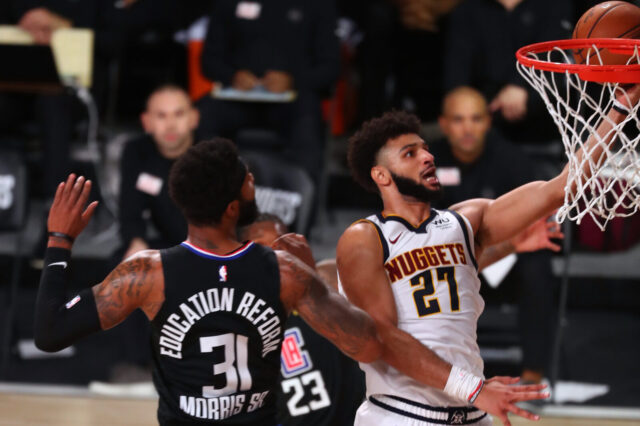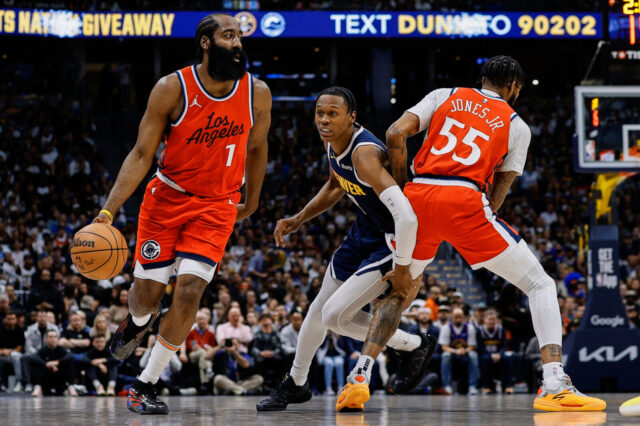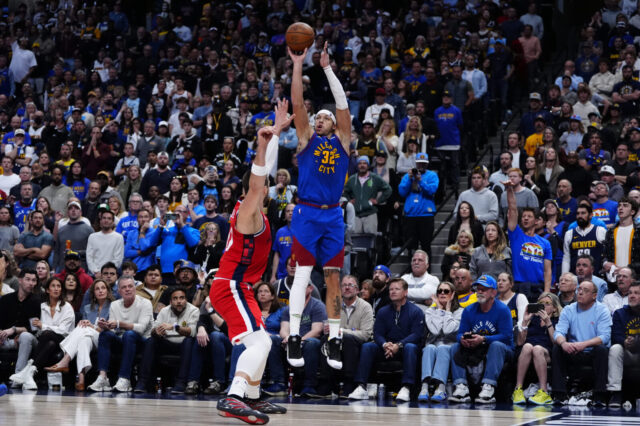Luck has not sided with the Denver Nuggets over the last two seasons.
Two summers ago, the Nuggets added Paul Millsap as an experienced and talented veteran to pair alongside Nikola Jokic and the rest of Denver’s young core. He’d join a starting lineup that included Gary Harris and Jamal Murray, while sprinkling in time alongside Will Barton, a quintet that was supposed to form the core of the team for at least the following two seasons.
But in the 2017-18 season, those five played just 14 games together before Millsap injured his left wrist, sidelining him for the next 44 games. When he returned in late February with limited use and flexibility in his left hand, Harris exited the lineup with a knee injury that would hold him out until the final week of the season.
“It’s like a comfort. We’ve been playing together so long that we don’t even have to talk, we just know certain things (we) got to do.”
This season, with Barton joining the other four in the starting lineup, the group made it just two games in before suffering a major injury, this time to Barton who would require surgery to repair a torn adductor muscle. He missed the next 38 games. Harris joined him on the injury report on December 5th with a hip injury. Millsap joined both of them on December 8th with a broken toe.
Almost comically, the team was set to play at full strength on January 25th but Jokic was suspended for leaving the bench during an on-court altercation the game before. During Jokic’s one-game absence, Murray sprained his ankle and was forced to miss the next couple of weeks. By the time he returned, both Harris and Millsap were back on the injury report and out of the lineup.
This content is no longer available.
In total, the Nuggets are 62 games into their second season with this core yet have seen their best five-man lineup start just four games together. They’ve only logged 134 total minutes over that two-year span, including just 69 minutes so far this season. That the team has been able to maintain a 42-20 record is a testament to the depth of the roster, the coaching of Michael Malone, and the talent of the team’s all-star, Nikola Jokic.
But there is plenty of evidence to suggest that Denver’s best is yet to come, beginning with the return of the starting lineup that has been two years in the making.
The idea behind this lineup is simple. Paul Millsap provides a defensive anchor in the frontcournt, capable of covering enough ground as a sort of free-safety to make up for some of Jokic’s defensive shortcomings. On offense, Millsap accepts a lower usage roll while doing much of the grunt work on the glass and as a weak side screener.
Murray, Harris, and Barton not only provide enough three-point shooting to space the floor, they are also all experienced and capable of effectively running pick and roll (PnR) and dribble handoff (DHO) action with Jokic.
Four years ago during Jokic’s rookie season, Barton and Jokic came off of the bench for the Nuggets and formed one of the league’s most efficient PnR duos. Over the next two seasons, Harris and Jokic became the staple of Denver’s offense, creating a chemistry on DHOs and back cuts that became the main pillar of “Jokic-ball.” Murray and Jokic have developed a similar chemistry over the last three years but it wasn’t until Barton and Harris went out of the lineup due to injuries this season that the two-man game between Murray and Jokic elevated to all new heights.
From December 5th, the date Harris first joined Barton on the injury report, until January 25th, the date Murray injured his left ankle, the Denver Nuggets had the 3rd highest net rating in “clutch” moments, according to NBA.com. “Clutch” minutes are defined as minutes in which the score is within 5 points during the final 5 minutes of a game. Denver played 42 such minutes over that span and were without Barton, Harris, and Millsap for most of that stretch. The Nuggets finished that 24-game run with a 16-8 record including 10-3 in “clutch” games.
Through 62 games, Murray and Jokic have thrown 206 assists to each other, more than any other duo in the NBA. (For reference, that’s only 9 fewer than LeBron James and Dwyane Wade threw to each other in any of their 4 seasons together in Miami)
There’s also a chemistry between Denver’s three guards. Over the past three season, those three players have all shared the court at the same time for over 1000 minutes. Any two of them have been on the court together for nearly 4000 minutes over that same timeframe.
“Especially for me, I just like having (Harris) next to me out there. It’s like a comfort,” Barton told reporters following the team’s win over the Oklahoma City Thunder last Tuesday, the game the Nuggets first saw the return of that five-man lineup. “We’ve been playing together so long that we don’t even have to talk, we just know certain things me and him got to do offensively and defensively. So, it’s like a shield for me and it’s a talented group.”
Last season, the lineup played just 65 minutes together but outscored opponents by 53 points. It’s too small of a sample size to draw conclusions but even if you look at lineups featuring Jokic and any three of those four players, you get a sample size of 1278 minutes and a +7.4 net rating.
This season, in just 69 minutes of action, the lineup has already outscored opponents by 55 points. The deeper you dig, the more impressive the numbers become. For example, that lineup has appeared in 12 different stretches this season and was a positive in 11 of those stretches and neutral in the other. Even more impressive is that many of those stretches came during “clutch” time, including one to power a 21-10 comeback win against the Clippers on opening night and another to stop a 28-7 4th quarter Thunder run last week.
This content is no longer available.
What is also encouraging about this lineup is that it doesn’t appear to be the result of a hot shooting streak. The lineup shot slightly better than average with that lineup but their success with the group has come across the board, from improved shot selection, rebounding, defense, and turnover rate.
This content is no longer available.
Most important of all, look at what happens to the team’s franchise centerpiece during these stretches. Jokic goes from an all-star caliber player to a hall of fame caliber player when playing alongside this lineup. In just 69 minutes, Jokic has scored 68 points on 19-30 shooting and 75.6% true shooting. If you prorated that scoring pace for Jokic’s season average of 31.2 minutes per game, it’d come out to 30.7 points, 10.0 rebounds, and 7.7 assists. In short, Jokic has scored at a Michael Jordan level of volume and efficiency in this lineup while maintaining his rebounding and assist averages. His 35-point “perfect” triple-double came in one of the 3 games that that lineup has started together this season.
There are reasons to think that the level of play is more or less sustainable in this lineup, both for Jokic individually and for the Nuggets as a whole. This lineup is tailor made to take advantage of Jokic’s unique skillset. Having two reliable PnR partners in the back court has been quite rare for Jokic throughout his career, let alone three.
His rookie season, Denver’s primary point guard was a 19-year-old Emmanuel Mudiay. In Jokic’s sophomore season he split his time playing with Mudiay, Murray, and much more frequently, alongside veteran point guard Jameer Nelson. It was the only time in Jokic’s career that he’s been paired alongside an experienced lead ball handler. He shot 58% from the field that season and ranked 4th in the NBA in true shooting percentage. Last season, a 19-year-old Murray got the nod at starting point guard while Mudiay played a majority of the backup minutes.
So the trio of Murray, Harris, and Barton provides far and away the best 1-2-3 punch that Jokic has had at his disposal.
And having that trio of ball-handlers and floor spacers are essential for maximizing the free-flowing style of play that defines the Jokic-led Nuggets. Possessions like the one below illustrate Denver’s offense at it’s best. Jokic quarterbacks the play by reading the court. He doesn’t like what he sees as Barton attempts to receive a DHO so he pulls the ball back, signaling for Barton to move on to his next read.
From there, Jokic transitions into a DHO and immediate re-screen with Murray as Barton and Millsap flow perfectly into a weak side pindown. All 5 players are working within the flow of an unscripted yet perfectly structured possession. The result is that Murray finds an opening to the rim for the easy layup.
Possessions like the one below look simple enough but they are predicated on Jokic’s ability to read the court and the team’s ability to read Jokic. All three guards being PnR and DHO options from any spot on the court means that the team has a near infinite combination of actions they can run without having to avoid a non-shooter or shaky ball-handler. Unique plays like this inverted PnR look effortless thanks to the talent surrounding the action and the timing of Millsap’s off-ball screening.
Even a simple double pindown DHO places the defense in an impossible pickle. Gary driving to his right off of a screen is one of the team’s most deadly actions. With two elite spot-up shooters spacing the floor on the weakside, Millsap popping to the wing, and Jokic rolling to the rim, the defense is forced to pick which way they’d like the Nuggets to score on them. Running the same action several times in a row often yields the same result.
And when the ball gets poppin’ just the slightest amount, defense start to look like a fighter who has taken one too many punches on the chin; equal parts stunned, confused, and off-rhythm.
At their best, this lineup wreaks havoc on even the most elite and disciplined defenses. There’s no roadmap to what the Nuggets are trying to do on any given possession so the defense can’t jump the action. There’s no player to shade off or poor shooter to leave open. Most important of all, there’s a chemistry that has been 2+ years in the making.
While injuries have largely robbed the Nuggets from seeing this lineup together, they’ve also opened the door for others to gain experience. Jokic and Mason Plumlee have developed a nice chemistry on both ends of the floor and are one of Denver’s best overall duos. Monte Morris and Malik Beasley have each had breakout seasons and are on the short list of players in the conversation for the league’s most improved player award. Lineups featuring those three plus Trey Lyles have a +6.1 net rating on the season on over 700 possessions.
The return of Isaiah Thomas has thrown a wrench into the bench rotation over the last two weeks but Denver knows that they have one of the league’s best starting lineups and one of the most consistent and reliable bench units in their back pocket should the Thomas experiment fail to pan out.
This is the team the Nuggets have been building toward since the summer of 2017. The Nuggets have managed to carve out the 2nd best record in the western conference but they are just now starting to deploy their most lethal weapon. Even with the most difficult stretch of their season right ahead, the Nuggets are in position to play their best basketball of the season leading into the playoffs.
The team Tim Connelly and Michael Malone have built is finally healthy. If they are even half as promising as they appear to be through 69 minutes, the rest of the league should take notice.


